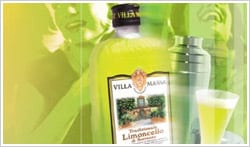 In honor of our special report on the Amalfi Coast, coming out later this month (subscribe to Dream of Italy today and it will be your first issue), here’s almost everything you wanted to know about the region’s most succulent drink:
In honor of our special report on the Amalfi Coast, coming out later this month (subscribe to Dream of Italy today and it will be your first issue), here’s almost everything you wanted to know about the region’s most succulent drink:
On the terraced hills of Italy’s Amalfi Coast, the Mediterranean sun and ocean air combine with volcanic soil to produce lemons the size of grapefruits. For hundreds of years, southern Italians have used the thick, juicy skins of these Sorrento lemons, named after the nearby town, to create a sweet tangy, liqueur known as limoncello (as the Italian word for lemon is limone). Historians suspect that limoncello, like many other regional liqueurs, was developed by local convents. In the 17th century, the nuns of Santa Rosa in Conca dei Marini used the lemon liqueur to make their famous lemon pastry, sfoglietta Santa Rosa.
For generations, local families have passed down their own recipes for macerating lemon peels to create limoncello. Only four ingredients may go into the liqueur – lemon zest (the colored portion of the peel), grain alcohol (or vodka), water and sugar – but Italians argue that much can go wrong if those ingredients are not up to par, or if the maceration process is interrupted. There are hidden pitfalls everywhere. For example, the limoncello may not turn out right if the alcohol is not strong enough. Some recipes allow two weeks for the mixture to ferment; others insist on as many as 80 days.

